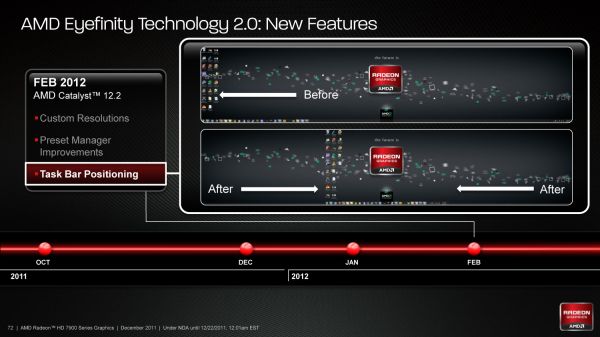AMD Radeon HD 7970 Review: 28nm And Graphics Core Next, Together As One
by Ryan Smith on December 22, 2011 12:00 AM EST- Posted in
- GPUs
- AMD
- Radeon
- ATI
- Radeon HD 7000
Display Tech: HD3D Eyefinity, MST Hubs, & DDM Audio
With the launch of the HD 5000 series back in 2009 AMD managed to get the drop on everyone, press and NVIDIA alike. Eyefinity, AMD’s Single Large Surface technology, came out of virtually nowhere thanks to a carefully orchestrated development plan that ensured very few people even within AMD knew about it. As a result of everything that was leaked ahead of time Eyefinity was not, making it AMD’s big eye catcher for the 5000 series.
As what was to be the first piece of the much dreamed about holodeck, AMD has been steadily working on it since 2009 in order to improve the experience even within their existing hardware by adding support for such features as bezel compensation and combining CrossFire with Eyefinity. For AMD it’s a feature of great importance even if end user adoption is still limited.
For the Southern Islands family AMD isn’t going to be pulling quite the rabbit out of their hat this time when it comes to displays. Southern Islands’ new display feature will be Discrete Digital Multi-Point Audio (which we’ll get to in a moment), but this doesn’t mean that AMD hasn’t continued to work on Eyefinity. Since October AMD has been engaged in an initiative they’re calling “Eyefinity Technology 2.0”, which is going to be pushed as a big part of the Southern Islands launch even though these are software improvements that will benefit all cards.
So what is Eyefinity Technology 2.0 composed of? We’ve already seen several new features starting with Catalyst 11.10, such as 5x1 portrait and landscape support and flexible bezel compensation support. The next step is going to be integrating Stereo 3D (or as AMD likes to call it, HD3D) into the mix, similar to how NVIDIA has 3D Vision Surround. Catalyst 11.12 introduced the ability to use HD3D with an Eyefinity display setup, and Catalyst 12.1 (preview out now) added support to do that in a CrossFire configuration. The final step is going to be with Catalyst 12.2 in February, which will add support for custom resolutions and the ability to relocate the Windows task bar to an arbitrary screen, two features that users have been asking about for quite some time. Again, all of these improvements are driver side, but they are a major component of AMD’s marketing for Southern Islands.
Speaking about Eyefinity, one issue that comes up time and time again is Multi Stream Transport (MST) hubs. We were introduced to MST hubs back with the launch of the 6800 series, which allowed a single DP 1.2 port to drive up to 4 monitors by taking advantage of the high bandwidth of DP1.2 and embedding transport streams for several monitors into the signal. The purpose of MST hubs was so that users could use several monitors with a regular Radeon card, rather than needing an exotic all-DisplayPort “Eyefinity edition” card as they need now.
But as many of you have asked me about, several deadlines for MST hubs have come and gone, including the latest deadline which was supposed to be by the end of this year. As with active DP adaptors this is largely out of AMD’s hands since they don’t produce the hardware, but they have been continuing to prod their partners on the issue. The latest deadline from AMD isn’t rosy – summer of 2012 – but they seem more confident of this deadline than deadlines in the past. Not that another half-year wait will be of any comfort for users who have been looking for MST hubs for the better part of the year, but at least it provides some idea on when to expect them.
Last, but certainly not least on the display technologies front is AMD’s new feature for Southern Islands, Discrete Digital Multi-Point Audio (DDMA). It’s a mouthful of a name but the concept is rather simple: it’s the next step in audio output from a video card. Video cards have been able to output audio for a few years now via HDMI, and more recently DisplayPort gained the ability. However GPUs have been limited to streaming audio to a single device, be it a monitor, TV, or receiver. With DDMA GPUs can send audio to multiple devices, and AMD is looking at how to put that ability to work.
The most basic use for being able to send audio to multiple devices is to individually address the speakers of each device, which is the cornerstone of AMD’s proposed use cases. Fundamentally AMD is looking at applications that involve matching audio streams to the monitor the relevant application is on – move a video player from your center monitor to your left monitor, and the audio from that video player should also move from the speakers on the middle monitor to the speakers on the left monitor. What can you do with speakers that are mapped to monitors? That’s what AMD wants to find out.
Being realistic for a moment, the 7970 isn’t going to be the card that sells this feature, as it’s a $550 gamer video card. Gamers are using dedicated 2.1/5.1/7.1 audio systems or headphones for surround sound, and while AMD does have a proposed multi-tasking use case for this it’s not very convincing. DDMA will become much more important on future lower end cards as those are the cards that go into family desktops, workstations, and the like. Thus the killer app for this feature (and certainly AMD’s best prepared scenario) is for video conferencing where each attendee is mapped to a monitor, and with DDMA a set of speakers on that monitor. AMD’s partner Oovoo is working on just such a system though it’s still early in development.












292 Comments
View All Comments
Ryan Smith - Thursday, December 22, 2011 - link
Since 1920x1200 has already been commented on elsewhere I'm just going to jump right to your comment on minimum FPS.I completely agree, and we're trying to add it where it makes sense. A lot of benchmarks are wildly inconsistent about their minimum FPS, largely thanks to the fact that minimum FPS is an instantaneous data point. When your values vary by 20%+ per run (as minimums often do), even averaging repeated trials isn't nearly accurate enough to present meaningful results.
CeriseCogburn - Thursday, March 8, 2012 - link
HardOCP shows long in game fps per second charts that show dips and bottom outs are more than one momentary lapse and often are extended time periods of lowest frame rate runs, so I have to respectfully disagree.Perhaps the fault is fraps can show you a single instance of lowest frame rate number, and hence it's the analysis that utterly fails - given the time constraints that were made obvious, it is also clear that the extra work it would take for an easily reasoned and reasonable result that is actually of worthy accuracy is not in the cards here.
thunderising - Thursday, December 22, 2011 - link
Okay. This card has left me thrilled, but wanting for more. Why?Well, for example, every reviewer has hit the CCC Core and Memory Max Limits, which turns into a healthy 10-12% performance boost, all for 10W.
What, legit reviews got it to 1165MHz core and 6550Mhz memory for a 21-24% increase in performance. Now that's HUGE!
I think AMD could have gone for something like this with the final clocks, to squeeze out every last bit of performance from this amazing card:
Core - 1050 MHz
Memory - 1500 MHz (6000MHz QDR)
This was not only easily achievable, but would have placed this card at a 8-10% increase in performance all for a mere <10W rise in Load Power.
Hoping for AIBs like Sapphire to show their magic! HD7970 Toxic, MmmmmmM...
Otherwise, fantastic card I say.
Death666Angel - Friday, December 23, 2011 - link
Maybe they'll do a 4870/4890 thing again? Launch the HD7970 and HD7970X2 and then launch a HD7990 with higher clocks later to counter nVidia.... Who knows. :-)Mishera - Sunday, December 25, 2011 - link
They've been doing it for quite some time now. Their plan has been to release a chip balancing die size, performance, and cost. Then later to compete on high end release a dual-chip card. Anand wrote on this a while ago with the rv770 story (http://www.anandtech.com/show/2679).Even looking at the picture of chip sizes, the 7970 is still a reasonable size. And this really was a brilliant move as though Nvidia has half the marketshare and does make a lot of money from their cards, their design philosophy has been hurting them a lot from a business standpoint.
On a side note, Amd really made a great choice by choosing to wait until now to push for general computing. Though that probably means more people to support development and drivers, which means more hiring which is the opposite way Amd has been going. It will be interesting to see how this dichotomy will develop in the future. But right now kudos to Amd.
CeriseCogburn - Thursday, March 8, 2012 - link
Does that mean amd is abandoning gamers as we heard the scream whilst Nvidia was doing thus ?I don't quite get it - now what nvidia did that hurt them, is praise worthy since amd did it, finally.
Forgive me as I scoff at the immense dichotomy...
"Perfect ripeness at the perfect time" - sorry not buying it....
privatosan - Thursday, December 22, 2011 - link
PRT is a nice feature, but there is an failure in the article:'For AMD’s technology each tile will be 64KB, which for an uncompressed 32bit texture would be enough room for a 4K x 4K chunk.'
The tile would be 128 x 128 texels; 4K x 4K would be quite big for a tile.
futrtrubl - Thursday, December 22, 2011 - link
I was going to comment on that too. A 4k x 4k x 32bit (4byte) texture chunk would be around 67MB uncompressed. For a 32bit texture you could only fit a 128x128 array in a 64KB chunk. An 8bit/pixel texture could be 4k*4kStonedofmoo - Thursday, December 22, 2011 - link
Thanks for the review. A request though...To the hardware sites doing these reviews, many of us in this day and age run dual monitor or more. It always frustrates in me in these reviews that we get a long write up on the power saving techniques the new cards use, and never any mention of it helps those of us running more than one display.
For those not in the know, if you run more than one display on all the current generations the cards do NOT downclock the GPU and memory nearly as much as they do on single montor configurations. This burns quite a lot more power and obviously kicks out more heat. No site ever mentions this which is odd considering so many of us have more than one display these days.
I would happily buy the card that finally overcomes this and actually finds a way of knocking back the clocks with multi-monitor setups. Is the new Radeon 7xxx series that card?
Galcobar - Thursday, December 22, 2011 - link
It's in the article, on the page entitled "Meet the Radeon 7970."Ryan also replied to a similar comment by quoting the paragraph addressing multi-monitor setups and power consumption at the top of page of the comments.
That's two mentions, and the answer to your question.